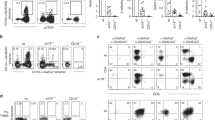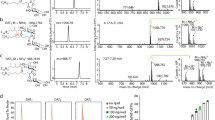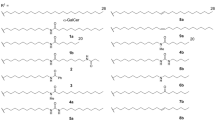Abstract
CD1 proteins present various glycolipid antigens to T cells, but the cellular mechanisms that control which particular glycolipids generate T cell responses are not understood. We show here that T cell recognition of glucose monomycolate antigens with long (C80) alkyl chains involves the delivery of CD1b proteins and antigens to late endosomes in a process that takes several hours. In contrast, analogs of the same antigen with shorter (C32) alkyl chains are rapidly, but inefficiently, presented by cell surface CD1b proteins. Dendritic cells (DCs) preferentially present long-chain glycolipids, which results, in part, from their rapid internalization and selective delivery of antigens to endosomal compartments. Nonprofessional antigen-presenting cells, however, preferentially present short-chain glycolipids because of their lack of prominent endosomal presentation pathways. Because long alkyl chain length distinguishes certain microbial glycolipids from common mammalian glycolipids, these findings suggest that DCs use a specialized endosomal-loading pathway to promote preferential recognition of glycolipids with a more intrinsically foreign structure.
This is a preview of subscription content, access via your institution
Access options
Subscribe to this journal
Receive 12 print issues and online access
$209.00 per year
only $17.42 per issue
Buy this article
- Purchase on Springer Link
- Instant access to full article PDF
Prices may be subject to local taxes which are calculated during checkout






Similar content being viewed by others
References
Calabi, F. & Milstein, C. The molecular biology of CD1. Semin. Immunol. 12, 503–509 (2000).
Porcelli, S. A. & Modlin, R. L. The CD1 system: antigen-presenting molecules for T cell recognition of lipids and glycolipids. Annu. Rev. Immunol. 17, 297–329 (1999).
Zeng, Z. et al. Crystal structure of mouse CD1: an MHC-like fold with a large hydrophobic binding groove. Science 277, 339–345 (1997).
Burdin, N. et al. Structural requirements for antigen presentation by mouse CD1. Proc. Natl. Acad. Sci. USA 97, 10156–10161 (2000).
Niazi, K. et al. The A′ and F′ pockets of human CD1b are both required for optimal presentation of lipid antigens to T cells. J. Immunol. 166, 2562–2570 (2001).
Ernst, W. A. et al. Molecular interaction of CD1b with lipoglycan antigens. Immunity 8, 331–340 (1998).
Joyce, S. et al. Natural ligand of mouse CD1d1: cellular glycosylphosphatidylinositol. Science 279, 1541–1544 (1998).
Naidenko, O. et al. Binding and antigen presentation of ceramide-containing glycolipids by soluble mound and human CD1d molecules. J. Exp. Med. 190, 1069–1079 (1999).
Grant, E. P. et al. Molecular recognition of lipid antigens by T cell receptors. J. Exp. Med. 189, 195–205 (1999).
Moody, D. B., Besra, G. S., Wilson, I. A. & Porcelli, S. A. The molecular basis of CD1-mediated presentation of lipid antigens. Immunol. Rev. 172, 285–296 (1999).
Kawano, T. et al. CD1d-restricted and TCR-mediated activation of Vα14 NKT cells by glycosylceramides. Science 278, 1626–1629 (1997).
Bendelac, A. CD1: presenting unusual antigens to unusual T lymphocytes. Science 269, 185–186 (1995).
Sieling, P. A. et al. CD1 expression by dendritic cells in human leprosy lesions: correlation with effective host immunity. J. Immunol. 162, 1851–1858 (1999).
Porcelli, S., Morita, C. T. & Brenner, M. B. CD1b restricts the response of human CD4−8− T lymphoyctes to a microbial antigen. Nature 360, 593–597 (1992).
Moody, D. B. et al. CD1c-mediated T cell recognition of mycobacterial glycolipids in M. tuberculosis infection. Nature 404, 884–888 (2000).
Gumperz, J. et al. Murine CD1d-restricted T cell recognition of cellular lipids. Immunity 12, 211–221 (2000).
Shamshiev, A. et al. Self glycolipids as T-cell autoantigens. Eur. J. Immunol. 29, 1667–1675 (1999).
Beckman, E. M. et al. Recognition of a lipid antigen by CD1-restricted αβ+ T cells. Nature 372, 691–694 (1994).
Sieling, P. A. et al. CD1-restricted T cell recognition of microbial lipoglycan antigens. Science 269, 227–230 (1995).
Moody, D. B. et al. Structural requirements for glycolipid antigen recognition by CD1b- restricted T cells. Science 278, 283–286 (1997).
Moody, D. B., Reinhold, B. B., Reinhold, V. N., Besra, G. S. & Porcelli, S. A. Uptake and processing of glycosylated mycolates for presentation to CD1b-restricted T cells. Immunol. Lett. 65, 85–91 (1999).
Jackman, R. M. et al. The tyrosine-containing cytoplasmic tail of CD1b is essential for its efficient presentation of bacterial lipid antigens. Immunity 8, 341–351 (1998).
Sugita, M. et al. Cytoplasmic tail-dependent localization of CD1b antigen-presenting molecules to MIICs. Science 273, 349–352 (1996).
Prigozy, T. I. et al. The mannose receptor delivers lipoglycan antigens to endosomes for presentation to T cells by CD1b molecules. Immunity 6, 187–197 (1997).
Shamshiev, A. et al. The αβ T cell response to self-glycolipids shows a novel mechanism of CD1b loading and a requirement for complex oligosaccharides. Immunity 13, 255–264 (2000).
Sacchettini, J. C. & Gordon, J. I. Rat intestinal fatty acid binding protein. A model system for analyzing the forces that can bind fatty acids to proteins. J. Biol. Chem. 268, 18399–18402 (1993).
Moody, D. B. et al. CD1b-mediated T cell recognition of a glycolipid antigen generated from mycobacterial lipid and host carbohydrate during infection. J. Exp. Med. 192, 965–976 (2000).
Datta, A. K., Takayama, K., Nashed, M. A. & Anderson, L. An improved synthesis of trehalose 6-mono- and 6,6′-dicorynemycolates and related esters. Carb. Res. 218, 95–109 (1991).
Mukherjee, S., Soe, T. T. & Maxfield, F. R. Endocytic sorting of lipid analogues differing solely in the chemistry of their hydrophobic tails. J. Cell Biol. 144, 1271–1284 (1999).
Briken, V., Jackman, R. M., Watts, G. F., Rogers, R. A. & Porcelli, S. A. Human CD1b and CD1c isoforms survey different intracellular compartments for the presentation of microbial lipid antigens. J. Exp. Med. 192, 281–288 (2000).
Lanzavecchia, A. Mechanisms of antigen uptake for presentation. Curr. Opin. Immunol. 8, 348–354 (1996).
Novak, E. J. & Rabinovitch, P. S. Improved sensitivity in flow cytometric intracellular ionized calcium measurement using fluo-3/Fura Red fluorescence ratios. Cytometry 17, 135–141 (1994).
Caras, I. W., Weddell, G. N., Davitz, M. A., Nussenzweig, V. & Martin, D. W. J. Signal for attachment of a phospholipid membrane anchor in decay accelerating factor. Science 238, 1280–1283 (1987).
Tykocinski, M. L. et al. Signal for attachment of a phospholipid membrane anchor in decay accelerating factor. Proc. Natl. Acad. Sci. USA 85, 3555–3559 (1988).
Geho, D. H. et al. Glycosyl-phosphatidylinositol reanchoring unmasks distinct antigen-presenting pathways for CD1b and CD1c. J. Immunol. 165, 1272–1277 (2000).
Kirchhausen, T., Bonifacino, J. S. & Riezman, H. Linking cargo to vesicle formation: receptor tail interactions with coat proteins. Curr. Opin. Cell Biol. 9, 488–495 (1997).
Martin, L. H., Calabi, F., Lefebvre, F. A., Bilsland, C. A. & Milstein, C. Structure and expression of the human thymocyte antigens CD1a, CD1b, and CD1c. Proc. Natl. Acad. Sci. USA 84, 9189–9193 (1987).
Porcelli, S. A. The CD1 family: a third lineage of antigen-presenting molecules. Adv. Immunol. 59, 1–98 (1995).
Bendelac, A. Positive selection of mouse NK1+ T cells by CD1-expressing cortical thymocytes. J. Exp. Med. 182, 2091–2096 (1995).
Coles, M. C. & Raulet, D. H. NK1. 1+ T cells in the liver arise in the thymus and are selected by interactions with class I molecules on CD4+CD8+ cells. J. Immunol. 164, 2412–2418 (2000).
Reinherz, E. L., Kung, P. C., Goldstein, G., Levey, R. H. & Schlossman, S. F. Discrete stages of human intrathymic differentiation: analysis of normal thymocytes and leukemic lymphoblasts of T-cell lineage. Proc. Natl. Acad. Sci. USA 77, 1588–1592 (1980).
Cresswell, P. Invariant chain structure and MHC class II function. Cell 84, 505–507 (1996).
Miyamoto, K., Miyake, S. & Yamamura, T. A synthetic glycolipid prevents autoimmune encephalomyelitis by inducing TH2 bias of natural killer T cells. Nature 413, 531–534 (2001).
Kaufmann, S. H. Immunity to intracellular microbial pathogens. Immunol. Today 16, 338–342 (1995).
Lee, R. E., Brennan, P. J. & Besra, G. S. Mycobacterium tuberculosis cell envelope. Curr. Top. Microbiol. Immunol. 215, 1–27 (1996).
Acknowledgements
We thank J. Gumperz, J. Hartt, M. Brenner and M. Sugita for advice and reagents; D. Olive for the 4A7 hybridoma cell line; P. Chavrier for the Rab5 antiserum; and I. Wilson and B. Segelke for molecular modeling studies of CD1 proteins. Supported by grants from the American College of Rheumatology Research and Education Foundation, the Human Frontiers Science Program, the Irene Diamond Foundation, NIAMS (ARO1988 to D. B. M.), the NIAID (AI49313, AI45889, AI48933, AI 31044 and AI 38960 to D. B. M., S. A. P. and M. L. T.), the NCI (CA74958 to M. L. T) and the Medical Research Council (49343 and G0000895 to G. S. B.).
Author information
Authors and Affiliations
Corresponding author
Ethics declarations
Competing interests
S. Porcelli is a paid consultant of Antigenics, a publicly held biotechnology company that also supports research in his laboratory. Antigenics is a licensee of several patents related to the application of antigen presentation by CD1 and has a commercial interest in further scientific development in this area.
Supplementary information
Rights and permissions
About this article
Cite this article
Moody, D., Briken, V., Cheng, TY. et al. Lipid length controls antigen entry into endosomal and nonendosomal pathways for CD1b presentation. Nat Immunol 3, 435–442 (2002). https://doi.org/10.1038/ni780
Received:
Accepted:
Published:
Issue Date:
DOI: https://doi.org/10.1038/ni780
This article is cited by
-
Synthetic mycobacterial diacyl trehaloses reveal differential recognition by human T cell receptors and the C-type lectin Mincle
Scientific Reports (2021)
-
The role of oxidised self-lipids and alveolar macrophage CD1b expression in COPD
Scientific Reports (2021)
-
Molecular recognition of microbial lipid-based antigens by T cells
Cellular and Molecular Life Sciences (2018)
-
Donor-unrestricted T cells in the human CD1 system
Immunogenetics (2016)
-
Lipid and small-molecule display by CD1 and MR1
Nature Reviews Immunology (2015)



